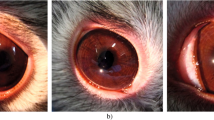Abstract
• Background: Endotoxin-induced uveitis (EIU) is an animal model of ocular inflammation, produced by footpad injection of endotoxin (lipopolysaccharide, LPS) to mimic the human disease of acute anterior uveitis, that is useful for testing new anti-inflammatory therapy. The purpose of this study was to test the anti-inflammatory effect on EIU of thalidomide and one of its derivatives, supidimide.
• Methods: EIU was produced in rats by hind footpad injection of LPS (100 μg/animal). Animals were killed 20 h after LPS injection. Inflammation was evaluated by anterior chamber determination of proteins and cells.
• Results: A dosage of 400 mg/kg per day of thalidomide was efficient in reducing inflammation whether given in three doses (at − 24 h, − 4 h and + 4 h relative to LPS challenge = THAL-1; p < 0.001 for proteins and cells), in two doses (−4 h and +4 h = THAL-2; p < 0.001 for proteins, p < 0.012 for cells) or in one dose (at +4 h=late THAL; p < 0.001 for proteins, p≤0.02 for cells). A dosage of 300 mg/kg per day of thalidomide was still efficient (p≤0.023 for proteins, p≤0.06 for cells), but 150 mg/kg per day had no effect on inflammation. Supidimide (400 mg/kg per day) had some anti-inflammatory effect (p ≤ 0.053 for proteins, p < 0.06 for cells).
• Conclusion: High-dose thalidomide had a potent anti-inflammatory effect in EIU, but lower doses were not sufficient to reduce inflammation. At similar high doses, supidimide had some effect on EIU but was less effective than thalidomide.
Similar content being viewed by others
References
Helm F-C, Frankus E, Friderichs E, Graudums I, Flohé L (1981) Comparative teratological investigation of compounds structurally and pharmacologically related to thalidomide. Arzneimittelforsch/Drug Res 31:941–949
Herbort CP, Okumura A, Mochizuki M (1988) Endotoxin-induced uveitis in the rat: a study of the role of inflammation mediators. Graefe's Arch Clin Exp Ophthalmol 226:553–558
Lenz W (1962) Thalidomide and congenital abnormalities. Lancet 11: 45–46
McBride WG (1961) Thalidomide and congenital abnormalities. Lancet ii: 1358
Moreira AL, Sampaio EP, Zmuidzinas A, Frindt P, Smith KA, Kaplan G (1993) Thalidomide exerts its inhibitory action on tumor necrosis factor α by enhancing mRNA degradation. J Exp Med 177:1675–1680
Neubert R, Nogueira AC, Neubert D (1993) Thalidomide derivatives and the immune system. I. Changes in the pattern of integrin receptors and other surface markers on T lymphocyte subpopulations of marmoset blood. Arch Toxicol 67:1–17
Ochonisky S, Verroust J, Bastujii-Garin S, Gehrardi R, Revuz J (1993) Thalidomide neuropathy: incidence and clinico-electrophysiological features in 42 patients. Rev Med Intern 14 [Suppl 1]: 108
Ramselaar CG, Boone RM, Kluin-Nelemans HC (1986) Thalidomide in the treatment of necro-Behçet's syndrome. Br J Dermatol 115:367–370
Sampaio EP, Sarno EN, Galilly R, Cohn ZA, Kaplan G (1991) Thalidomide selectively inhibits tumor necrosis factor production by stimulated human monocytes. J Exp Med 173:699–703
Saylan T, Saltik I (1982) Thalidomide in the treatment of Behçet's syndrome. Arch Dermatol 118:536
Sheskin J (1965) Thalidomide in the treatment of lepra reaction. Clin Pharmacol Ther 6:303–306
Tamura F, Vogelsang GB, Reitz BA, Baumgartner WA, Herskowitz A (1990) Combination thalidomide and cyclosporine for cardiac allograft rejection. Comparison with methylprednisolone and cyclosporine. Transplantation 49:20–25
Vogelsang GB, Taylor S, Gordon G, Hess AD (1986) Thalidomide, a potent agent for treatment of graft-versus-host disease. Transplant Proc 18:904–906
Vogelsang GB, Farmer ER, Hess AD, Altamonte V, Beschorner WE, Jabs DA, Corio RL, Levin LS, Colvin OM, Wingard JR, Santos GW (1992) Thalidomide for the treatment of chronic graft-versus-host disease. N Engl J Med 326:1055–1058
Author information
Authors and Affiliations
Additional information
These data were presented in part at the first annual ECORA meeting, 4–6 October, 1993, Bonn, Germany
Rights and permissions
About this article
Cite this article
Guex-Crosier, Y., Pittet, N. & Herbort, C.P. The effect of thalidomide and supidimide on endotoxin-induced uveitis in rats. Graefe's Arch Clin Exp Ophthalmol 233, 90–93 (1995). https://doi.org/10.1007/BF00241478
Received:
Revised:
Accepted:
Issue Date:
DOI: https://doi.org/10.1007/BF00241478




